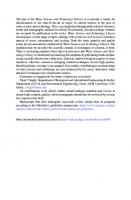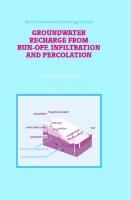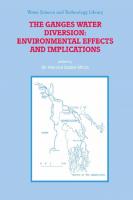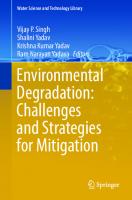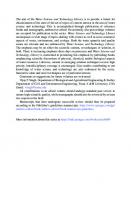Environmental Processes and Management: Tools and Practices for Groundwater (Water Science and Technology Library, 120) 9783031202070, 9783031202087, 3031202074
This book is Volume 2 which is published to complement "Environmental Processes and Management: Tools and Practices
153 28 8MB
English Pages 376 [363]
Table of contents :
Contents
Contributors
Abbreviations
1 Non-invasive Subsurface Groundwater Exploration Techniques
1.1 Non-invasive Methods
1.1.1 Applications of the ERT and Surface NMR
1.2 Principles of Electrical Resistivity Tomography
1.2.1 Schlumberger Array Configuration
1.2.2 Wenner Array Configuration
1.2.3 Dipole–Dipole Array Configuration
1.2.4 2D Electrical Resistivity Tomography
1.2.5 ERT Survey at Belra, Roorkee
1.3 The Principle of Surface NMR
1.3.1 Surface NMR Survey at Belra, Roorkee
1.4 Summary
References
2 Numerical Solution of Space Fractional Advection–Dispersion Equation and Application
2.1 Introduction
2.2 Theoretical Concepts
2.2.1 Equations Influencing ADE
2.2.2 Equations Influencing sFADE
2.2.3 sFADE Equations and Its Numerical Solution
2.2.4 Experimental Procedure
2.2.5 Results and Discussion
2.3 Summary
References
3 Contaminant Transport Modeling for Homogeneous and Heterogeneous Porous Systems Using MODFLOW Models-Based Scripting Python Package
3.1 Introduction
3.2 Methodology
3.2.1 Modeling Approach
3.3 Results and Discussion
3.3.1 Analyzing Non-linear and Non-equilibrium Sorption Isotherms Using 1-D Reactive Transport Modeling
3.3.2 Analyzing the Contaminant Plume Evolution Dynamics for the Homogeneous and Heterogeneous Porous Systems Using 2-D Vertical Transport Model
3.4 Conclusion
References
4 Site Suitability Analysis for Identification of Riverbank Filtration (RBF) Sites: Case Study of the Alaknanda River Basin
4.1 GIS-Based Site Suitability Analysis
4.1.1 Methodology for Suitable Site Identification
4.1.2 Data and Software
4.2 General Boundary Defining for Analysis
4.2.1 Defining Horizontal and Vertical Boundary
4.3 Different Thematic Maps for Suitability Analysis
4.3.1 Land Use/Land Cover
4.3.2 Stream Network Map
4.3.3 Geological Map
4.3.4 Slope Map
4.4 Scoring and Ranking of Thematic Maps
4.5 Suitability Map with Weighting System
4.6 Groundwater Flow Modeling
4.6.1 Area and Grid Formation for Model
4.6.2 Input Parameters for Modeling
4.6.3 Drawdown
4.6.4 Particle Transport
4.7 Riverbank Purification Capacity Analysis
4.7.1 River Meandering and Its River Water Purification Capacity
4.7.2 Water Filtration Quantity
4.8 Discussion
4.9 Conclusion
References
5 A Systematic Review on Groundwater Management: Opportunities and Challenges
5.1 Introduction
5.2 The Role of Groundwater
5.2.1 Importance
5.3 Groundwater Management and Challenges
5.4 Climate Change and Groundwater
5.4.1 Impacts
5.5 Opportunities for Improving Groundwater Management
5.6 Conclusions and Recommendations
References
6 Chemicals in the Water: A Serious Concern for the Humans and Aquatic Life
6.1 Introduction
6.2 Major Chemicals Toxicants of Water Environment
6.2.1 Heavy Metals
6.3 Pesticides
6.4 Radioactive Waste
6.5 Conclusion and Recommendation
References
7 Potential Impacts of Climatic Changes and Human Activity on Water Quality
7.1 Introduction
7.2 Water Contamination
7.3 Conclusion and Perspective
References
8 Groundwater Vulnerability Assessment Using Drastic Method: A Case Study of Bhilwara District, Rajasthan
8.1 Introduction
8.1.1 Scope of the Work
8.1.2 Objectives
8.2 Study Area
8.2.1 General Depiction
8.2.2 Topography
8.2.3 Geological Setup
8.2.4 Hydrogeology
8.3 Methodology
8.3.1 Introduction
8.3.2 Procedure
8.3.3 Preparing Layer Maps
8.3.4 Violation
8.3.5 Mapping of Hotspots
8.3.6 Overlay Analysis
8.3.7 Calculation of Water Quality Index
8.4 Results and Discussions
8.4.1 Evaluation of Vulnerability
8.4.2 Validation
8.4.3 Evaluation of %Age Violation W.R.T Drinking Water Standard
8.4.4 Overlay
8.4.5 Water Quality Index (WQI)
8.5 Conclusions
References
9 Exploring the Sustainable Water Management and Human Well Being Nexus in Indian Context
9.1 Introduction
9.1.1 Water Policy Needs for Sustainable Management
9.2 Study Area and Rationale for the Study
9.3 Preliminary Studies
9.3.1 Groundwater Quality
9.3.2 Results of Informal Survey
9.4 Investigations Undertaken
9.4.1 Defluoridation Potential of Local Clays
9.4.2 Alternate Rainwater Harvesting System for JUET
9.4.3 Feasibility Studies for Multiple Aerobic Lagoons
9.5 Tradeoffs for Policy Framework
9.5.1 Centralized Administration Versus Decentralized Participatory Approaches
9.5.2 Energy Efficiency Versus Land Availability
9.5.3 Replenishment of Resources Versus Consumption Patterns
9.5.4 Natural Pollutants Versus Anthropogenic Pollutants
9.5.5 Actual Scenario Versus Awareness Among Stakeholders
9.5.6 Ecological Concerns Versus Economics of Management
9.6 Concluding Remarks
References
10 Linkages of Surface Water with Groundwater for Water Resource Management in Water Deficit Region of India
10.1 Introduction
10.2 Surface and Groundwater Potential Along with Its Availability
10.2.1 Hydrologic Response Unit and Surface Runoff Potential
10.2.2 Modeling of Groundwater Recharge Potential and Availability
10.3 Integration of Surface Water and Groundwater
10.4 Conclusions
References
11 Water Resource Management—A Sustainable Approach Towards Ground Water Conservation
11.1 Introduction
11.2 Materials and Methods
11.2.1 Components of Watershed Management
11.2.2 Watershed Management Practices
11.3 Result and Discussion
11.3.1 Watershed Management
11.4 Conclusion
References
12 Evaluation of Hydrogeological Models and Big Data for Quantifying Groundwater Use in Regional River Systems
12.1 Introduction
12.2 Study Area
12.2.1 Hydrogeological Characteristics
12.2.2 Groundwater Resources
12.3 Materials and Methods
12.3.1 Big Data Collection
12.3.2 Hydrogeological Modeling Using SWAT-FEM Model
12.3.3 Quantifying Groundwater Use
12.4 Results and Discussion
12.4.1 True Groundwater Trends
12.4.2 Hydrogeological Predictions Using SWAT-FEM
12.4.3 SWAT-FEM-Based Groundwater Predictions
12.4.4 Variation of Spatiotemporal Groundwater Use
12.5 Conclusions
References
13 Integrated Water Resources Management: Perspective for State of Uttarakhand, India
13.1 Introduction
13.1.1 Integrated Water Resources Management
13.2 Water Issues of Uttarakhand
13.3 River Morphology and Its Effects
13.3.1 River Morphology
13.3.2 Theoretical Value for Sinuosity
13.3.3 Relationship Between Purification Capacity and Sinuosity
13.3.4 Riverbank Filtration as an Element of IWRM
13.4 Role of Geographical Information System (GIS) in IWRM
13.4.1 Use of GIS and RS in Land Suitability Analysis
13.4.2 Groundwater Flow Modeling for Purification Capacity Analysis
13.5 Conclusion
References
14 Water Resource Estimation and Management: Case Study of the Alaknanda River Basin
14.1 Study Area: Alaknanda River Basin
14.1.1 Geography and Geology
14.1.2 Hydrology
14.1.3 River Morphology
14.1.4 Demography
14.1.5 Climate Condition
14.1.6 Rainfall, Temperature and Humidity
14.1.7 The Main Towns and Features of the River Stretch
14.1.8 Hydroelectric Dam
14.2 Existing Water Sources of Study Area
14.2.1 Ground Water
14.2.2 Spring Water
14.2.3 Rainwater
14.2.4 Surface Water
14.3 River Water Quality
14.4 Water Demand
14.4.1 Domestic Water Demand
14.4.2 Agriculture Water Demand
14.4.3 Options to Meet the Agricultural Water Demand
14.4.4 Gaps in Water Supply and Demand
14.5 Existing Water Abstraction and Treatment Schemes
14.5.1 Management Issues in Water Abstraction and Supply
14.5.2 Sewage Water Management
14.5.3 Higher Capital Costs
14.5.4 Higher Operation and Maintenance Costs
14.6 Summary
References
15 Impact of Flooding on Agricultural Crops—An Overview
15.1 Impact of Flooding on Soil Properties
References
16 Study of Rising Surface Water Levels on Land Submergence and Groundwater
16.1 Introduction
16.2 Study Area
16.3 Methodology
16.4 Hydrological Analysis
16.4.1 About Terrain Preprocessing
16.4.2 Data Management—Terrain Preprocessing
16.4.3 Drainage Network
16.5 Creation of Potential Flooding Sites
16.6 Evaluation of Submergence Area
16.7 Impacts of Urbanization on Groundwater Systems and Recharge
16.8 Outlook for Groundwater in Urban Area
16.8.1 Rainfall Recharge
16.8.2 Method of Fluctuation of Groundwater Levels
16.9 Assessment of Groundwater in Water Level Depletion Zones
16.10 Groundwater Status in Lucknow City
16.11 Conclusions
References
17 Impact of Climatic Changes on Groundwater Regime: A Case Study of Tinsukia District, Assam, India
17.1 Introduction
17.2 Study Area
17.3 Data Source
17.4 Data Processing
17.4.1 MK Test
17.4.2 Sen’s Slope Estimation
17.5 Result and Discussion
17.5.1 Trend Analysis for Temperature
17.5.2 Trend Analysis for Rainfall
17.5.3 Trend Analysis for Groundwater Level
17.6 Conclusion
References
18 Evaluation of Groundwater Contamination Due to Solid Waste Management
18.1 Introduction
18.2 Scenario of Solid Waste in India
18.3 Impact of Solid Waste on Groundwater Quality
18.4 Assessment and Monitoring of Groundwater
18.5 Effects of Decomposition of Waste Products on Groundwater Quality
18.6 Effects of Gas on Groundwater
18.7 Conclusions
References
19 Groundwater Toxicity Link to Epidemiology of Parkinson’s Disease
19.1 Introduction
19.2 Overview of Groundwater and Usage
19.3 Overview of Groundwater Toxicity
19.4 Overview of Parkinson’s Disease
19.4.1 Overall Disease Burden
19.4.2 Identifying Etiology
19.4.3 Understanding Pathogenesis of Organic Molecule
19.4.4 Toxicological Evidence of Pesticides
19.5 Conclusion
References
20 GIS for Groundwater Resources and Contamination Risk Assessment
20.1 Introduction
20.2 Applications of GIS in Water Resources
20.3 Applications of GIS in Groundwater Hydrology
20.4 Application of GIS for Assessment and Exploration of Groundwater Resources
20.5 GIS Application for Groundwater Pollution Hazard Assessment and Protection Planning
20.6 Limitations of GIS for Groundwater Resource Management
20.7 Conclusions and Discussions
References
21 Water Quality Modelling and Parameter Assessment Using Machine Learning Algorithms: A Case Study of Ganga and Yamuna Rivers in Prayagraj, Uttar Pradesh, India
21.1 Introduction
21.2 Methodology
21.2.1 Details of Sampling Sites
21.2.2 Correlation Matrix
21.2.3 ANN
21.2.4 GA
21.2.5 Linear Correlation
21.3 Results and Discussion
21.3.1 Selection of Modelling Parameters
21.3.2 Simulation of Prediction Models Based on Selected Parameters
21.3.3 Comparison for Results from the General Predictive Models
21.4 Conclusions
References
22 Response of Groundwater Level to Climate Variability: A Case Study of Mirzapur, Uttar Pradesh, India
22.1 Introduction
22.2 Methodology
22.3 Study Area
22.4 Data Set
22.5 Results and Discussion
22.5.1 Nonparametric Test Results of Two Climatic Variables—Annual Average Rainfall and Temperature
22.5.2 Nonparametric Test Results of GroundWater Level (GWL)
22.6 Conclusion
References
Contents
Contributors
Abbreviations
1 Non-invasive Subsurface Groundwater Exploration Techniques
1.1 Non-invasive Methods
1.1.1 Applications of the ERT and Surface NMR
1.2 Principles of Electrical Resistivity Tomography
1.2.1 Schlumberger Array Configuration
1.2.2 Wenner Array Configuration
1.2.3 Dipole–Dipole Array Configuration
1.2.4 2D Electrical Resistivity Tomography
1.2.5 ERT Survey at Belra, Roorkee
1.3 The Principle of Surface NMR
1.3.1 Surface NMR Survey at Belra, Roorkee
1.4 Summary
References
2 Numerical Solution of Space Fractional Advection–Dispersion Equation and Application
2.1 Introduction
2.2 Theoretical Concepts
2.2.1 Equations Influencing ADE
2.2.2 Equations Influencing sFADE
2.2.3 sFADE Equations and Its Numerical Solution
2.2.4 Experimental Procedure
2.2.5 Results and Discussion
2.3 Summary
References
3 Contaminant Transport Modeling for Homogeneous and Heterogeneous Porous Systems Using MODFLOW Models-Based Scripting Python Package
3.1 Introduction
3.2 Methodology
3.2.1 Modeling Approach
3.3 Results and Discussion
3.3.1 Analyzing Non-linear and Non-equilibrium Sorption Isotherms Using 1-D Reactive Transport Modeling
3.3.2 Analyzing the Contaminant Plume Evolution Dynamics for the Homogeneous and Heterogeneous Porous Systems Using 2-D Vertical Transport Model
3.4 Conclusion
References
4 Site Suitability Analysis for Identification of Riverbank Filtration (RBF) Sites: Case Study of the Alaknanda River Basin
4.1 GIS-Based Site Suitability Analysis
4.1.1 Methodology for Suitable Site Identification
4.1.2 Data and Software
4.2 General Boundary Defining for Analysis
4.2.1 Defining Horizontal and Vertical Boundary
4.3 Different Thematic Maps for Suitability Analysis
4.3.1 Land Use/Land Cover
4.3.2 Stream Network Map
4.3.3 Geological Map
4.3.4 Slope Map
4.4 Scoring and Ranking of Thematic Maps
4.5 Suitability Map with Weighting System
4.6 Groundwater Flow Modeling
4.6.1 Area and Grid Formation for Model
4.6.2 Input Parameters for Modeling
4.6.3 Drawdown
4.6.4 Particle Transport
4.7 Riverbank Purification Capacity Analysis
4.7.1 River Meandering and Its River Water Purification Capacity
4.7.2 Water Filtration Quantity
4.8 Discussion
4.9 Conclusion
References
5 A Systematic Review on Groundwater Management: Opportunities and Challenges
5.1 Introduction
5.2 The Role of Groundwater
5.2.1 Importance
5.3 Groundwater Management and Challenges
5.4 Climate Change and Groundwater
5.4.1 Impacts
5.5 Opportunities for Improving Groundwater Management
5.6 Conclusions and Recommendations
References
6 Chemicals in the Water: A Serious Concern for the Humans and Aquatic Life
6.1 Introduction
6.2 Major Chemicals Toxicants of Water Environment
6.2.1 Heavy Metals
6.3 Pesticides
6.4 Radioactive Waste
6.5 Conclusion and Recommendation
References
7 Potential Impacts of Climatic Changes and Human Activity on Water Quality
7.1 Introduction
7.2 Water Contamination
7.3 Conclusion and Perspective
References
8 Groundwater Vulnerability Assessment Using Drastic Method: A Case Study of Bhilwara District, Rajasthan
8.1 Introduction
8.1.1 Scope of the Work
8.1.2 Objectives
8.2 Study Area
8.2.1 General Depiction
8.2.2 Topography
8.2.3 Geological Setup
8.2.4 Hydrogeology
8.3 Methodology
8.3.1 Introduction
8.3.2 Procedure
8.3.3 Preparing Layer Maps
8.3.4 Violation
8.3.5 Mapping of Hotspots
8.3.6 Overlay Analysis
8.3.7 Calculation of Water Quality Index
8.4 Results and Discussions
8.4.1 Evaluation of Vulnerability
8.4.2 Validation
8.4.3 Evaluation of %Age Violation W.R.T Drinking Water Standard
8.4.4 Overlay
8.4.5 Water Quality Index (WQI)
8.5 Conclusions
References
9 Exploring the Sustainable Water Management and Human Well Being Nexus in Indian Context
9.1 Introduction
9.1.1 Water Policy Needs for Sustainable Management
9.2 Study Area and Rationale for the Study
9.3 Preliminary Studies
9.3.1 Groundwater Quality
9.3.2 Results of Informal Survey
9.4 Investigations Undertaken
9.4.1 Defluoridation Potential of Local Clays
9.4.2 Alternate Rainwater Harvesting System for JUET
9.4.3 Feasibility Studies for Multiple Aerobic Lagoons
9.5 Tradeoffs for Policy Framework
9.5.1 Centralized Administration Versus Decentralized Participatory Approaches
9.5.2 Energy Efficiency Versus Land Availability
9.5.3 Replenishment of Resources Versus Consumption Patterns
9.5.4 Natural Pollutants Versus Anthropogenic Pollutants
9.5.5 Actual Scenario Versus Awareness Among Stakeholders
9.5.6 Ecological Concerns Versus Economics of Management
9.6 Concluding Remarks
References
10 Linkages of Surface Water with Groundwater for Water Resource Management in Water Deficit Region of India
10.1 Introduction
10.2 Surface and Groundwater Potential Along with Its Availability
10.2.1 Hydrologic Response Unit and Surface Runoff Potential
10.2.2 Modeling of Groundwater Recharge Potential and Availability
10.3 Integration of Surface Water and Groundwater
10.4 Conclusions
References
11 Water Resource Management—A Sustainable Approach Towards Ground Water Conservation
11.1 Introduction
11.2 Materials and Methods
11.2.1 Components of Watershed Management
11.2.2 Watershed Management Practices
11.3 Result and Discussion
11.3.1 Watershed Management
11.4 Conclusion
References
12 Evaluation of Hydrogeological Models and Big Data for Quantifying Groundwater Use in Regional River Systems
12.1 Introduction
12.2 Study Area
12.2.1 Hydrogeological Characteristics
12.2.2 Groundwater Resources
12.3 Materials and Methods
12.3.1 Big Data Collection
12.3.2 Hydrogeological Modeling Using SWAT-FEM Model
12.3.3 Quantifying Groundwater Use
12.4 Results and Discussion
12.4.1 True Groundwater Trends
12.4.2 Hydrogeological Predictions Using SWAT-FEM
12.4.3 SWAT-FEM-Based Groundwater Predictions
12.4.4 Variation of Spatiotemporal Groundwater Use
12.5 Conclusions
References
13 Integrated Water Resources Management: Perspective for State of Uttarakhand, India
13.1 Introduction
13.1.1 Integrated Water Resources Management
13.2 Water Issues of Uttarakhand
13.3 River Morphology and Its Effects
13.3.1 River Morphology
13.3.2 Theoretical Value for Sinuosity
13.3.3 Relationship Between Purification Capacity and Sinuosity
13.3.4 Riverbank Filtration as an Element of IWRM
13.4 Role of Geographical Information System (GIS) in IWRM
13.4.1 Use of GIS and RS in Land Suitability Analysis
13.4.2 Groundwater Flow Modeling for Purification Capacity Analysis
13.5 Conclusion
References
14 Water Resource Estimation and Management: Case Study of the Alaknanda River Basin
14.1 Study Area: Alaknanda River Basin
14.1.1 Geography and Geology
14.1.2 Hydrology
14.1.3 River Morphology
14.1.4 Demography
14.1.5 Climate Condition
14.1.6 Rainfall, Temperature and Humidity
14.1.7 The Main Towns and Features of the River Stretch
14.1.8 Hydroelectric Dam
14.2 Existing Water Sources of Study Area
14.2.1 Ground Water
14.2.2 Spring Water
14.2.3 Rainwater
14.2.4 Surface Water
14.3 River Water Quality
14.4 Water Demand
14.4.1 Domestic Water Demand
14.4.2 Agriculture Water Demand
14.4.3 Options to Meet the Agricultural Water Demand
14.4.4 Gaps in Water Supply and Demand
14.5 Existing Water Abstraction and Treatment Schemes
14.5.1 Management Issues in Water Abstraction and Supply
14.5.2 Sewage Water Management
14.5.3 Higher Capital Costs
14.5.4 Higher Operation and Maintenance Costs
14.6 Summary
References
15 Impact of Flooding on Agricultural Crops—An Overview
15.1 Impact of Flooding on Soil Properties
References
16 Study of Rising Surface Water Levels on Land Submergence and Groundwater
16.1 Introduction
16.2 Study Area
16.3 Methodology
16.4 Hydrological Analysis
16.4.1 About Terrain Preprocessing
16.4.2 Data Management—Terrain Preprocessing
16.4.3 Drainage Network
16.5 Creation of Potential Flooding Sites
16.6 Evaluation of Submergence Area
16.7 Impacts of Urbanization on Groundwater Systems and Recharge
16.8 Outlook for Groundwater in Urban Area
16.8.1 Rainfall Recharge
16.8.2 Method of Fluctuation of Groundwater Levels
16.9 Assessment of Groundwater in Water Level Depletion Zones
16.10 Groundwater Status in Lucknow City
16.11 Conclusions
References
17 Impact of Climatic Changes on Groundwater Regime: A Case Study of Tinsukia District, Assam, India
17.1 Introduction
17.2 Study Area
17.3 Data Source
17.4 Data Processing
17.4.1 MK Test
17.4.2 Sen’s Slope Estimation
17.5 Result and Discussion
17.5.1 Trend Analysis for Temperature
17.5.2 Trend Analysis for Rainfall
17.5.3 Trend Analysis for Groundwater Level
17.6 Conclusion
References
18 Evaluation of Groundwater Contamination Due to Solid Waste Management
18.1 Introduction
18.2 Scenario of Solid Waste in India
18.3 Impact of Solid Waste on Groundwater Quality
18.4 Assessment and Monitoring of Groundwater
18.5 Effects of Decomposition of Waste Products on Groundwater Quality
18.6 Effects of Gas on Groundwater
18.7 Conclusions
References
19 Groundwater Toxicity Link to Epidemiology of Parkinson’s Disease
19.1 Introduction
19.2 Overview of Groundwater and Usage
19.3 Overview of Groundwater Toxicity
19.4 Overview of Parkinson’s Disease
19.4.1 Overall Disease Burden
19.4.2 Identifying Etiology
19.4.3 Understanding Pathogenesis of Organic Molecule
19.4.4 Toxicological Evidence of Pesticides
19.5 Conclusion
References
20 GIS for Groundwater Resources and Contamination Risk Assessment
20.1 Introduction
20.2 Applications of GIS in Water Resources
20.3 Applications of GIS in Groundwater Hydrology
20.4 Application of GIS for Assessment and Exploration of Groundwater Resources
20.5 GIS Application for Groundwater Pollution Hazard Assessment and Protection Planning
20.6 Limitations of GIS for Groundwater Resource Management
20.7 Conclusions and Discussions
References
21 Water Quality Modelling and Parameter Assessment Using Machine Learning Algorithms: A Case Study of Ganga and Yamuna Rivers in Prayagraj, Uttar Pradesh, India
21.1 Introduction
21.2 Methodology
21.2.1 Details of Sampling Sites
21.2.2 Correlation Matrix
21.2.3 ANN
21.2.4 GA
21.2.5 Linear Correlation
21.3 Results and Discussion
21.3.1 Selection of Modelling Parameters
21.3.2 Simulation of Prediction Models Based on Selected Parameters
21.3.3 Comparison for Results from the General Predictive Models
21.4 Conclusions
References
22 Response of Groundwater Level to Climate Variability: A Case Study of Mirzapur, Uttar Pradesh, India
22.1 Introduction
22.2 Methodology
22.3 Study Area
22.4 Data Set
22.5 Results and Discussion
22.5.1 Nonparametric Test Results of Two Climatic Variables—Annual Average Rainfall and Temperature
22.5.2 Nonparametric Test Results of GroundWater Level (GWL)
22.6 Conclusion
References

- Author / Uploaded
- Prabhakar Shukla (editor)
- Prachi Singh (editor)
- Raj Mohan Singh (editor)


